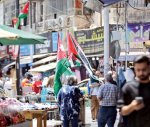You are here
Petra sees highest visitor numbers since pandemic outbreak
By JT - Oct 05,2021 - Last updated at Oct 05,2021

A balloon lands in Petra at the start of the recent Jordanian Meteorite Festival (Photo courtesy of PDTRA)
AMMAN — The Petra Development and Tourism Region Authority (PDTRA) in September registered the highest number of monthly tourists since the outbreak of the COVID-19 pandemic in March, 2020, PDTRA said on Tuesday.
A total of 23,751 guests visited Petra city in September, including 12,637 non-Arab visitors, 8,161 Jordanians and 2,946 non-Jordanian Arabs.
In September, 2020, there were only 16,381 guests, including 219 non-Arab visitors, 16,381 Jordanians and zero non-Jordanian Arabs, according to a PDTRA statement.
PDTRA Chief Commissioner Suleiman Farajat said that the increase in the tourist numbers has indicated the beginning of tourism recovery in Petra.
Farajat said that the recovery has contributed to resuming operations in hotels, restaurants and shops.
He also expected an even greater increase of tourists at the beginning of November due to the start of low-cost airline flights that are government subsidised.
Farajat said that PDTRA, during the lockdowns and the low numbers of tourists, rehabilitated tracks at the archaeological site in Petra and opened new projects, such as the heritage village.
The chief commissioner also noted that the authority adopted a new transport plan and inaugurated a bridge linking Wadi Mousa with the tourist street. The authority also replaced horse-drawn carts with environment-friendly electric vehicles.
The pandemic has greatly affected the tourism sector in Petra, where most facilities closed due to the epidemiological conditions that affected the entire world.
More than 80 per cent of Petra residents were affected by the stall in tourism.
Related Articles
AMMAN — The Petra Development and Tourism Region Authority (PDTRA) in November registered the highest number of monthly tourists since the o
AMMAN — A total of 39,272 tourists of various nationalities visited Petra in October, compared with only 360 guests in October 2020, figures
AMMAN — Approximately 905,000 tourists visited Petra in 2022, the Petra Development and Tourism Region Authority (PDTRA) said on Sunday, not

















